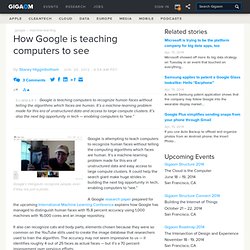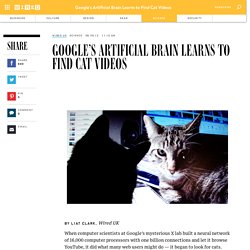

Kairos Lands $500K To Bring Facial Recognition Tech To Employee Time Clocks. Kairos, a startup that launched earlier this year out of the Spring 2012 class of the NewMe Accelerator, has landed $500,000 in seed funding from a group of angel backers.

The money will be put toward launching Kairos’ flagship app TimeClock, which launches in beta today. Facedeals, System Allows Automatic Facebook Check-ins With Facial Recognition. Microsoft figures out how to make a nearly perfect 3D model of the human face. Microsoft's system picks up the complex nuances of an actor's facial expressions.

Image: Microsoft Research You know you’re on to something in computer graphics when you get to explain in your research paper how you’ve advanced the state of the art beyond The Matrix: Reloaded and the Beowulf remake. In a paper to be presented at the SIGGRAPH computer graphics conference in Vancouver, B.C., this week, Microsoft researchers tip their hats to the technologies used in those movies for accurate 3D computer modeling of the human face.
But the researchers, from Microsoft’s Beijing lab, say they’ve figured out how to do it even better. The technique they’ve come up with can automatically model faces with a new level of accuracy — down to the last wrinkle. Facebook's Mobile Strategy is Flawed, Eye-Tracking Study Indicates. Fresh off of a lackluster second-quarter earnings release and new lows in its share price, Facebook was dealt more bad news on Friday when EyeTrackShop, a firm that measures audience attention, released a study suggesting that Facebook’s business model may be broken.

The culprit? The same mobile ads that CEO Mark Zuckerberg and COO Sheryl Sandberg lauded when they spoke with analysts Thursday afternoon. EyeTrackShop analyzes webcam imagery to track the eye movements of individual audience members while they attend to onscreen content. The firm's study examined audience attention to ads displayed by Facebook on its website as well as on its apps for iPhone and iPad.
While adds displayed in iPad apps generally did better than those on the Website, ads displayed on the iPhone performed poorly. How Google is teaching computers to see. Google’s Hangouts recognize people, even if they are just a photo.

Google is attempting to teach computers to recognize human faces without telling the computing algorithms which faces are human. It’s a machine-learning problem made for this era of unstructured data and easy access to large compute clusters. It could help the search giant make huge strides in building the next big opportunity in tech, enabling computers to “see.”
A Google research paper prepared for the upcoming International Machine Learning Conference explains how Google has managed to distinguish human faces with 15.8 percent accuracy using 1,000 machines with 16,000 cores and an image repository. It also can recognize cats and body parts, elements chosen because they were so common on the YouTube stills used to create the image database that researchers used to train the algorithm. Google’s Hangouts knows pictures of people from pictures of dogs. Source: Google People see using their eyes and their brains. Google's Artificial Brain Learns to Find Cat Videos. By Liat Clark, Wired UK When computer scientists at Google’s mysterious X lab built a neural network of 16,000 computer processors with one billion connections and let it browse YouTube, it did what many web users might do — it began to look for cats.

[partner id=”wireduk”] The “brain” simulation was exposed to 10 million randomly selected YouTube video thumbnails over the course of three days and, after being presented with a list of 20,000 different items, it began to recognize pictures of cats using a “deep learning” algorithm. This was despite being fed no information on distinguishing features that might help identify one. Picking up on the most commonly occurring images featured on YouTube, the system achieved 81.7 percent accuracy in detecting human faces, 76.7 percent accuracy when identifying human body parts and 74.8 percent accuracy when identifying cats. “The network is sensitive to high-level concepts such as cat faces and human bodies. Image: peasap/Flickr Source: Wired.co.uk. FREE Face Recognition API, Face Recognition Software Apps for the masses – face.com. Apple Patent Describes a More Secure Face-Recognition System. An Apple face-recognition patent shows how 3-D imaging could provide for better system security.

Images: Free Patents Online A new Apple patent application concerning face-recognition technology suggests an interesting security update for iOS. And that could be just the beginning of what the technology might enable. The patent, “3D Object Recognition,” describes a novel way to generate 3-D models using 2-D images. It’s a follow-up to a patent Apple already owns, originally filed by Swedish firm Polar Rose, which Apple purchased in late 2010.
In essence, the technology would use multiple photos, or even video, to create a robust 3-D representation of a user’s face. The system has obvious applications in system security — namely, a home screen unlocking mechanism that’s not easily fooled.